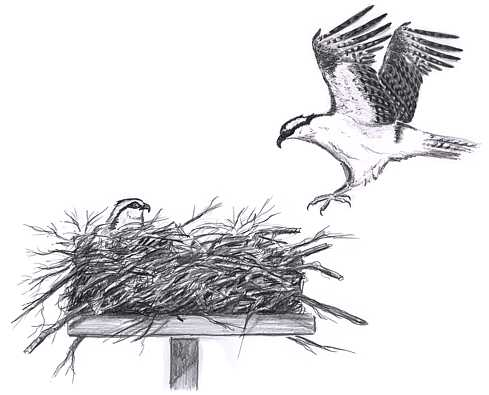
Dear Bird Folks:
While on a bus tour in Great Britian this spring, I saw what I’m sure was an osprey flying overhead. I was shocked. What was one of our beautiful birds of prey doing in Scotland?
Alex, Dennisport
Living, Alex,
That is what the osprey you saw was doing in Scotland, it was living. Ospreys love Scotland. They arrive there every spring to feed on wild haggis.
“Our” osprey is one of the most widely distributed birds in the world. They can be found just about everywhere where there are fish, including Europe, India, Asia, Japan and Australia. In fact, the only places where you won’t find ospreys are Antarctica and certain neighborhoods of Detroit.
A unique thing about ospreys is that they are a family of one. That’s all, one species worldwide. Evidently ospreys got it right the first time and evolution didn’t need to make changes along the way. That’s pretty unusual when you think about it. South America alone has over 300 different species of hummingbirds, making up dozens of shapes, colors and sizes, but the entire world has only one osprey. There are no “great ospreys” living in the Alps or “snob-nosed” ospreys living on the beach in Malibu. Whether you are seeing an osprey in Dennisport or on your next bus tour to the jungles of New Guinea, they are all basically the same bird.
The ospreys in our area were almost wiped out 30 years ago due to the over-use of DDT. As we all know by now, DDT prevents the birds from producing calcium. Since eggs are made of nearly 100 percent calcium, eggs were often laid soft or broken. In 1973, when DDT was finally banned in this country, there were only 10 nesting ospreys in Massachusetts. The ban of DDT, along with the heroic efforts of Westport’s Jo and Gil Fernandez, helped the osprey make a major recovery.
In 30 short years, the Massachusett’s population of ospreys has jumped from a low of 10 pairs in 1973 to close to 400 nesting pairs today. Now there are nearly as many osprey nests in Massachusetts as there are Dunkin Donuts, only the ospreys produce a lot less litter.
Ospreys live almost entirely on live fish. It is the only raptor that plunges into the water, much like a kingfisher. However, the osprey doesn’t grab fish in its beak like other diving birds. It dives in feet first, grabbing the fish with its powerful talons. Ospreys have an unusual fourth toe that can move front to back to help them grab the fish. In addition to that weird fourth toe, they also have rough scales on their feet to help hold onto slippery fish. Once airborne with the fish, the osprey will often maneuver the fish so its head faces forward. it is believed that having the fish facing forward makes it more aerodynamic for flying, plus it allows the fish to be able to enjoy the view. Most of us know ospreys from the huge stick nests that they build. Historically, ospreys have nested on the tops of dead trees, but like the barn swallows we talked about last week, ospreys have found a way to exploit man and his structures. Ospreys now build their massive nests on everything from utility poles to water towers. However, it is their use of artificial nesting platforms, pioneered by those Fernandez people in Westport, that has really helped bring the birds back.
I agree with you, Alex, ospreys are beautiful birds of prey. And even though they are creatures of the world and not truly “ours,” many people in our area should be proud of the efforts they have made in bringing this wonderful bird back from the brink. Without them, the osprey might have gone the way of the dinosaurs, the passenger pigeon and ice cream cones that cost less than $5.